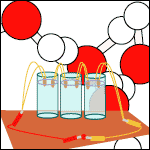Ions
Created | Updated Mar 2, 2009

Ions are electrically-charged atoms or molecules1. People who don't really know what ions are tend to be afraid of them because they have heard something about 'ionising radiation' or 'ion guns'. Few realise that ions are constantly being eaten because they're needed to do the chemistry inside our bodies.
Many have heard about phosphate and sulphate, or have read about magnesium or iron on a cornflakes packet. These are ions. At first it might seem surprising that most of the things we use in our daily life are somehow related to ions. On the other hand we all remember the electrical sparks when leaving the car on a dry day or from touching the monitor screen of the computer after switching it off. A closer look will show that ions are ubiquitous: the minerals dissolved in water are ionised; our body needs ions to work properly (for signalling in the nervous system, for example, or as reaction centres in many enzymes);, most of the chemical reactions involve separations of charge or ionic intermediates.
Some nomenclature: negatively-charged ions are called anions - for example2:
- Chloride (1-)
- Sulphate (2-)
- Phosphate (3-)
- Silicate (4-)
- Nitrite (1-)
- Hydride (1-)
While positively-charged ions are called cations, such as:
- Ammonium (1+)
- Sodium(1+)
- Potassium(1+)
- Calcium(2+)
- Iron(3+)
- Osmium(8+)
Charged Matter
As we all know, everything is generally made out of atoms, and atoms, in turn, are made out of a positively charged nucleus and a cloud of speeding negatively-charged electrons (cf also electron shells and orbitals). Normally the charges balance because the amount of protons (which are responsible for the positive charges in the nucleus) and the amount of electrons is the same. The same holds for molecules, the number of protons and the number of electrons is the same most of the time3.
For an atom or a molecule to get charged it will have to either lose one electron or gain at least one electron (or also a proton for that matter, but that's more complicated and only happens rarely). In any case the atom will become an ion and the process of losing or gaining charge is called ionisation.
Ionisation
Brute Force
Colliding high energy particles with atoms. If the energy of the particle is high enough it will eventually kick one electron out of the atom's orbitals or even split the nucleus. The left-over is normally an ion. Such high energy particles can be found in radioactive radiation, which is for that reason also called ionising radiation. This process also occurs naturally in the higher layers of our atmosphere where high energy particles from the sun ionise the atoms there. For that reason this layer is also called the ionosphere.
Softly
Most of chemistry is very roughly explained by the constant struggle of elements or molecules to bind or share electrons. Certain particles bind additional electrons well, at the expense of becoming a charged anion afterwards. Other elements or molecules can't hold their own electrons strongly enough, losing them to the aforementioned binding particles, and thus becoming ionised, charged cations. In most cases a balance is reached, and in the end the electrons will be distributed among the elements according to their binding strength. When the difference in this strength is high - this is the case with most mineral salts - then the elements exist in an ionised form sticking together by electrostatic attraction (this could start an academic discussion on its own, but in a first approximation, that's how it works). Like in the famous table salt or NaCl (aka sodium chloride), where the sodium loses one electron to the chlorine. When the difference is small, the molecules tend to share the electron in a covalent bond, but that's another story. Many mineral salts will dissolve in water to form dissolved ions, which are often termed 'electrolytes'.
Where to Find Ions
As mentioned before, ions are virtually everywhere. Water, for instance, has a the remarkable capability of dissolving ions well. It does that so well, that it even dissolves itself. For that reason all of the water contains ions. Seawater for example contains dissolved salt (NaCl) in the form of positively charged sodium cations and negatively charged chlorine anions in a huge number. There are 30-40g of salt dissolved in one litre of seawater. Normal tap water contains 10-100 mg/l calcium-cations (Ca2+), 35-70 mg/l sulphate-anions (SO42-), 10 mg/l magnesium-cations (Mg2+), 10 mg/l chloride-anions (Cl-) and many other ions in smaller amounts. The ions in the water of living organisms is crucial for their function.
More examples: DNA is a huge negatively charged ion. Many crystals contain ions, which are responsible for the colour of the crystal (Fe ions are responsible for the red colour of ruby).

